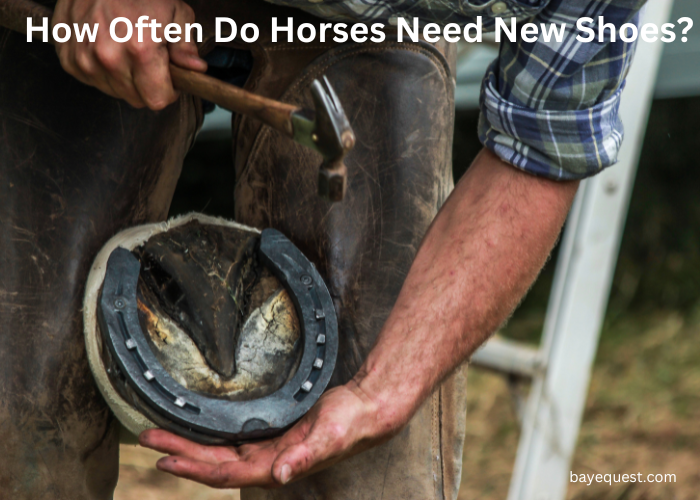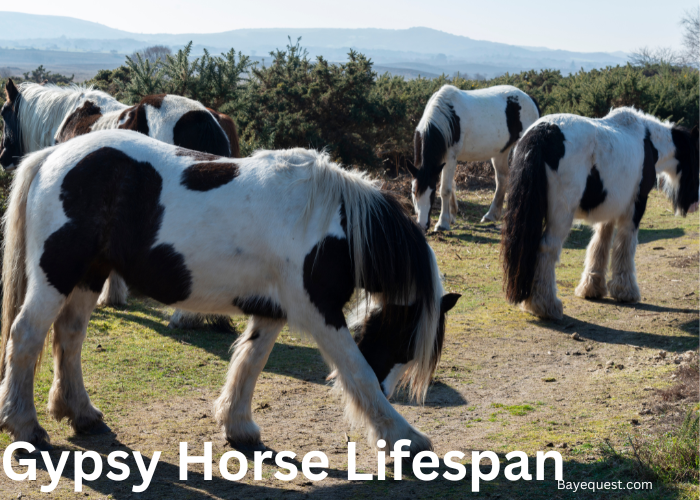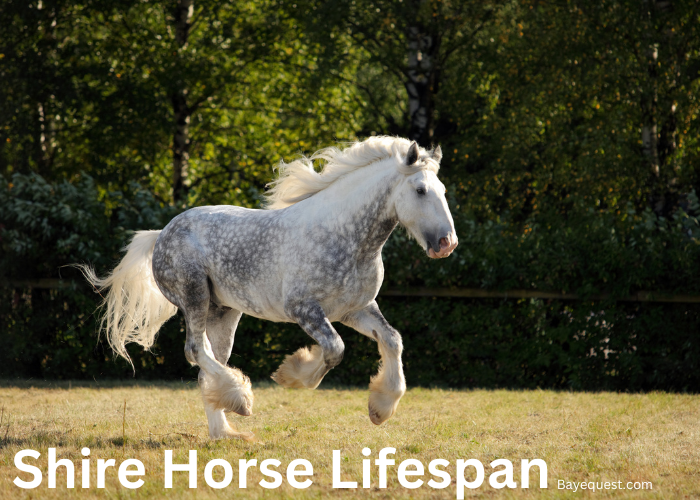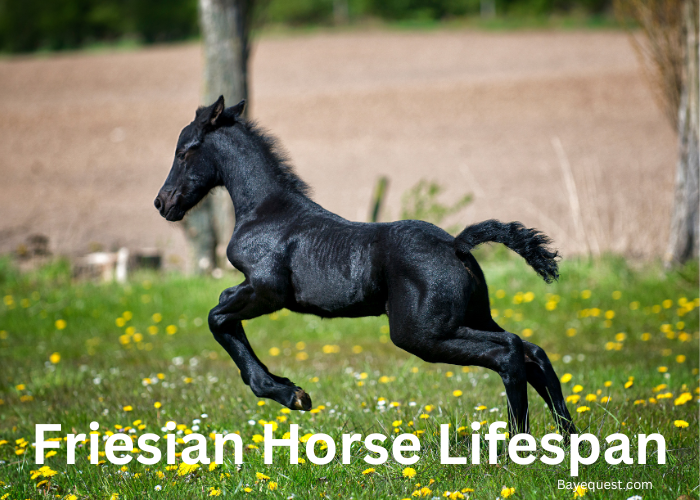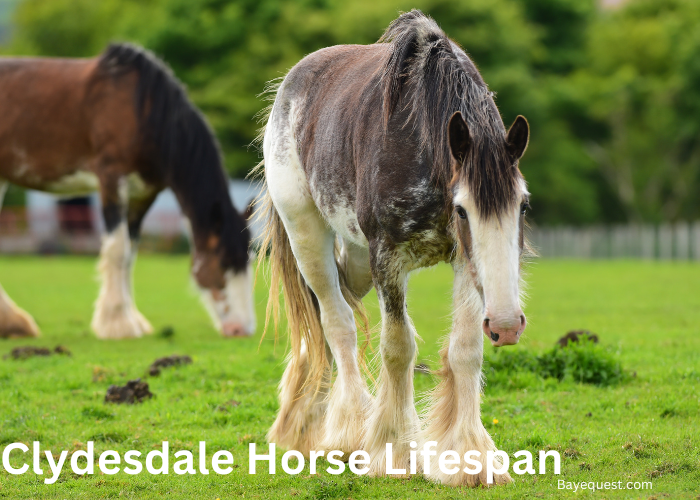Horses need good shoes just like we do. But how often should they get a new pair?
That’s a question many horse owners face. It’s not as simple as marking a date on the calendar. Different horses, different needs.
The ground they walk on, the work they do, and even their health can all play a part. So, let’s break it down.
We’ll talk about what to look for, when to call the farrier, and why it matters to keep those hooves in top shape.
How Often Do Horses Need New Shoes? Key Takeaway
Horses need new shoes every four to six weeks because their hooves grow continuously. Even if the shoes aren’t worn out, regular re-shoeing is necessary. Unlike unshod horses, which can naturally wear down hooves, shod horses need trimming and shoe replacement to maintain hoof health.
Do Horses Need Shoes?
Yes, many horses need shoes, but it depends on several factors.
Active horses often need shoes to protect their hooves from excessive wear and provide better traction on various terrains. Similarly, horses living in environments with rocky or hard surfaces benefit from the protection that shoes offer against hoof damage.
However, not all horses require shoes. Those that are less active or live on softer terrains may be perfectly healthy without them.
Whether a horse should wear shoes is determined by its specific activities, environment, and the condition of its hooves.
Related read: Do Horse Shoes Hurt Horses?
Why Do Horses Wear Shoes?
Horses wear shoes for several good reasons. Here are some of them:
Protection. The most basic reason horses wear shoes is to protect their hooves. Think about walking barefoot on a rocky path—that would be tough, right? It’s the same for horses. Their hooves can easily get bruised or cracked from rocks, hard ground, and other rough surfaces without shoes.
Traction. Shoes help horses get better grip. On soft ground, like mud or grass, horseshoes can help prevent slipping. For horses that work or perform, like racehorses or show jumpers, specific shoes can provide the right kind of traction for their sport.
Corrective purposes. Some horses have hoof or leg issues that can be corrected or helped with special shoes. For instance, if a horse’s hooves don’t wear evenly, shoes can help balance them out. This is similar to how some people need orthotics to help align their feet.
Durability. Horses’ hooves wear down from use, and shoes help slow down this wear. This is important for working horses whose hooves are under more stress from carrying loads or pulling weight.
Performance enhancement. Different shoes can enhance a horse’s performance in various disciplines. Racing horses, for instance, might wear lighter shoes to run faster, while trail horses have sturdier shoes.
When Should You Reshoe a Horse?
Horses need new shoes every four to six weeks. Why so often? Well, their hooves grow continuously, just like your fingernails. As they grow, the shoes don’t fit as well anymore.
Plus, just like the soles of your sneakers wear out, horseshoes get worn down too. They need to be in good shape to protect the horse’s hooves from rocks, pavement, and other rough surfaces.
Whether your horse is a backyard buddy or a show jumper, regular shoeing keeps them happy and healthy on their feet.
Factors Influencing Shoeing Frequency
The frequency at which a horse needs new shoes isn’t a one-size-fits-all situation. Several factors come into play:
Hoof growth rate. Just like people’s hair grows at different rates, so do horses’ hooves. Typically, hooves grow about a quarter of an inch per month, but this can vary. Faster-growing hooves might need more frequent shoeing.
Activity level. What the horse does on a daily basis really matters. A horse that competes or trains heavily will wear out shoes faster than a leisure horse. More work means more shoe wear.
Terrain. The type of ground a horse walks on affects how quickly shoes wear out. Rocky, hard, or abrasive surfaces will wear down shoes faster than soft, sandy, or muddy terrain.
Type of shoes. Different materials and designs of horseshoes last differently under various conditions. Steel shoes might last longer than aluminum ones, for instance.
Seasonal changes. Weather and seasons can influence hoof growth and shoe wear. In some horses, hooves grow faster in the summer due to better blood circulation and more movement.
Horse’s age and health. Younger and more active horses might need reshoeing more often, while older horses or those with certain health conditions might have different needs.
Read also: How do wild horses trim their hooves?
Pros and Cons of Shoeing a Horse
Shoeing a horse can provide many benefits but also has some drawbacks. Here are the pros and cons:
Pros
- Shoes protect the hooves from wear, tear, and damage due to hard, rocky, or abrasive surfaces.
- Shoes enhance grip and stability, especially on slippery surfaces, which helps prevent slips and falls.
- Specialized shoes can provide extra support to horses with hoof or leg problems, helping to correct structural issues and improve comfort.
- Shoes can improve a horse’s performance in various activities. These include racing, jumping, or trekking, by providing better traction and reducing fatigue.
- Shoes can help maintain hoof shape and integrity, especially in horses that have weak or brittle hooves.
Cons
- Regular shoeing can be expensive, as it requires a skilled farrier every 4-6 weeks.
- Poorly fitted shoes or mistakes in the shoeing process can cause hoof damage, pain, and other musculoskeletal issues.
- Once a horse starts wearing shoes, its hooves can become dependent on them leading to weaker hooves.
- Horseshoes require regular maintenance and checks. If a shoe is lost or becomes loose, it needs to be addressed immediately to avoid hoof damage.
Why Do You Need to Reshoe a Horse?
Reshoeing is not just about replacing old shoes but is an integral part of a horse’s routine care. Here’s why reshoeing is so important:
Hoof growth management. Horse hooves grow continuously, similar to human nails. As they grow, the shape of the hoof changes, which can alter the fit of the horseshoe. Regular reshoeing ensures that shoes fit properly to keep the hooves in good shape.
Prevent injury. Ill-fitting shoes can cause discomfort and may lead to injuries. As hooves grow and wear down, the nails holding the shoes can become loose, increasing the risk of the shoe falling off or shifting. A shifted shoe can lead to uneven weight distribution, which might cause strain on ligaments, tendons, and joints.
Maintain traction and protection. Shoes provide traction and protect the hooves from harsh surfaces. Reshoeing is necessary to replace worn-down shoes that no longer offer adequate protection or traction.
Corrective shoeing. For horses with hoof or limb abnormalities, reshoeing helps to maintain the corrective balance. Regular adjustments to the shoes can help manage or correct these issues over time.
Enhanced performance. In performance horses reshoeing is vital to maintain peak condition. Properly fitting shoes ensure optimal performance by providing the necessary support and traction.
Comfort. Regular reshoeing helps to keep the hooves well-trimmed and the shoes well-fitted. This enhances comfort and prevents pain that can arise from poorly fitted or worn-out shoes.
Read also: Who Invented Horseshoes?
Signs That It’s Time for New Shoes
Knowing when it’s time to get new shoes for a horse is key to maintaining their hoof health and overall well-being. Here are some clear signs that indicate it’s time for a shoe change:
Worn down shoes. If the shoes look visibly thin, bent, or worn out, it’s time to replace them. Shoes that have lost their shape or tread can’t provide the necessary protection or traction.
Loose shoes. When horseshoes start to become loose, they can clank or even shift on the hoof. This is a clear sign that they’re no longer securely fitted.
Twisted or shifted shoes. If the shoe doesn’t sit flat against the hoof anymore, or if it has shifted so that parts of the hoof are exposed where they shouldn’t be, it’s time for a reshoe.
Missing nails. Shoes missing one or more nails are at risk of coming off completely, which can lead to an uneven gait or injury.
Changes in gait. If a horse starts walking differently, limping, or showing signs of discomfort while moving, it could be due to uncomfortable or ill-fitting shoes.
Hoof growth. As hooves grow, shoes may no longer fit correctly. Overgrown hooves can affect the shoe’s effectiveness and the horse’s comfort.
Cracks in the hoof. Visible cracks or damage to the hoof itself can indicate that the shoes are not protecting the hooves as they should, necessitating a change.
Noise. Unusual noises like clinking or increased hoof sound on hard surfaces can indicate that the shoes are loose or worn.
The Reshoeing Process
The reshoeing process for horses is a meticulous procedure. Here’s a step-by-step breakdown of how it goes:
Step 1: Cleaning and inspection. The farrier begins by cleaning the horse’s hooves and removing any mud, debris, or stones stuck in the hoof or old shoe. This allows for a thorough inspection of the hoof’s condition, looking for any signs of damage, disease, or abnormal wear.
Step 2: Removal of old shoes. The farrier carefully removes the old shoes using specialized tools. This involves prying out the nails and gently pulling the shoe away from the hoof.
Step 3: Trimming the hoof. Next, the farrier trims the excess growth of the hoof. This is akin to trimming nails and is crucial for maintaining the proper shape and health of the hoof. The farrier trims the hoof wall, sole, and frog (the softer part in the center of the hoof), ensuring everything is even and balanced.
Step 4: Preparation for new shoes. After trimming, the farrier files and smooths the edges of the hoof to prepare a clean, flat surface that will fit the new shoe snugly.
Step 5: Fitting the new shoe. The farrier selects a shoe that matches the horse’s hoof size, activity needs, and health. The shoe is heated in a forge and sometimes molded to fit the exact shape of the trimmed hoof for a perfect fit.
Step 6: Attaching the shoe. The shoe is nailed to the hoof. Farriers use special nails that are designed to go through the tough part of the hoof wall and bend outward, clinching them over the edge to hold the shoe without hurting the horse.
Step 7: Final adjustments and filing. Once the shoe is nailed in place, the farrier makes necessary adjustments to ensure the shoe is well aligned. The farrier may file down any sharp edges or points from the nails to prevent injuries.
Step 8: Quality check and clean-up. The farrier checks the horse’s stance and may watch it walk to ensure comfort and proper fit. The hooves are cleaned up once more to remove any filing residues.
Step 9: Post-reshoeing care advice. Finally, the farrier will give you advice on caring for the horse’s newly shod hooves.
How Much Does Shoeing a Horse Cost?
The cost of shoeing a horse can vary quite a bit, depending on where you are, what kind of shoes your horse needs, and the expertise of the farrier.
On average, you might expect to pay anywhere from $100 to $250 for a basic shoeing job. If your horse needs special shoes, like those for correcting hoof problems or for specific sports, the cost can go up.
Also, if you’re in a region where there are fewer farriers, or if your farrier is particularly well-known for their skills, you might pay a bit more.
To Shoe or Not to Shoe Your Horse?
Deciding whether to shoe your horse isn’t a one-size-fits-all answer. Here’s a simple way to think about it:
If your horse is active, like racing or trail riding on rough terrain, shoes can help. They protect the hooves from wear and tear and give your horse a better grip, keeping your horse safer and more comfortable.
But if your horse hangs out mostly in soft pastures or doesn’t do heavy work, it might not need shoes. Going barefoot can be good for these horses. It lets their hooves strengthen naturally.
So, think about what your horse does most of the day and where it walks. This can help you decide if shoes are necessary or if your horse would be better off without them.
Read also: Why do horses eat their poop?
FAQs
Are there alternatives to traditional horseshoes?
Yes, there are alternatives to traditional metal horseshoes. These include removable hoof boots that can be used as needed. There are also glue-on shoes, which are ideal for horses with sensitive hooves or conditions that prevent nailing.
Can I extend the lifespan of horseshoes?
Yes, you can extend the lifespan of horseshoes with proper maintenance. Regular cleaning of the hooves and shoes helps prevent debris and chemicals from corroding the metal. Avoiding harsh terrain that excessively wears down the shoes can also prolong their life. Additionally, having your farrier regularly check and adjust the fit of the shoes can prevent premature wear.
Is shoeing horses painful?
No, shoeing horses is not painful when done correctly. A horse’s hooves are similar to the nails on human fingers; they do not have nerve endings in the areas where the shoe is nailed. A skilled farrier knows how to attach shoes without causing discomfort or harm to the horse.
How long can a horse go without shoes?
How long a horse can go without shoes depends on its activities, environment, and hoof health. Horses that live in soft, forgiving environments and do not perform hard labor might never need shoes. However, horses used for work or those on rough terrains may need regular shoeing to protect their hooves.
Conclusion
So, there you have it—how often horses need new shoes is a bit like finding the perfect fit for your favorite pair of sneakers. Just as you wouldn’t wait until your shoes are falling apart to get a new pair, keeping an eye on your horse’s hooves is essential.
Whether they’re trotting through trails or racing around the track, regular shoeing keeps them on their toes.
So, next time you hear the clink of a horseshoe, remember the care and attention it takes to keep our hoofed friends happy and healthy.




